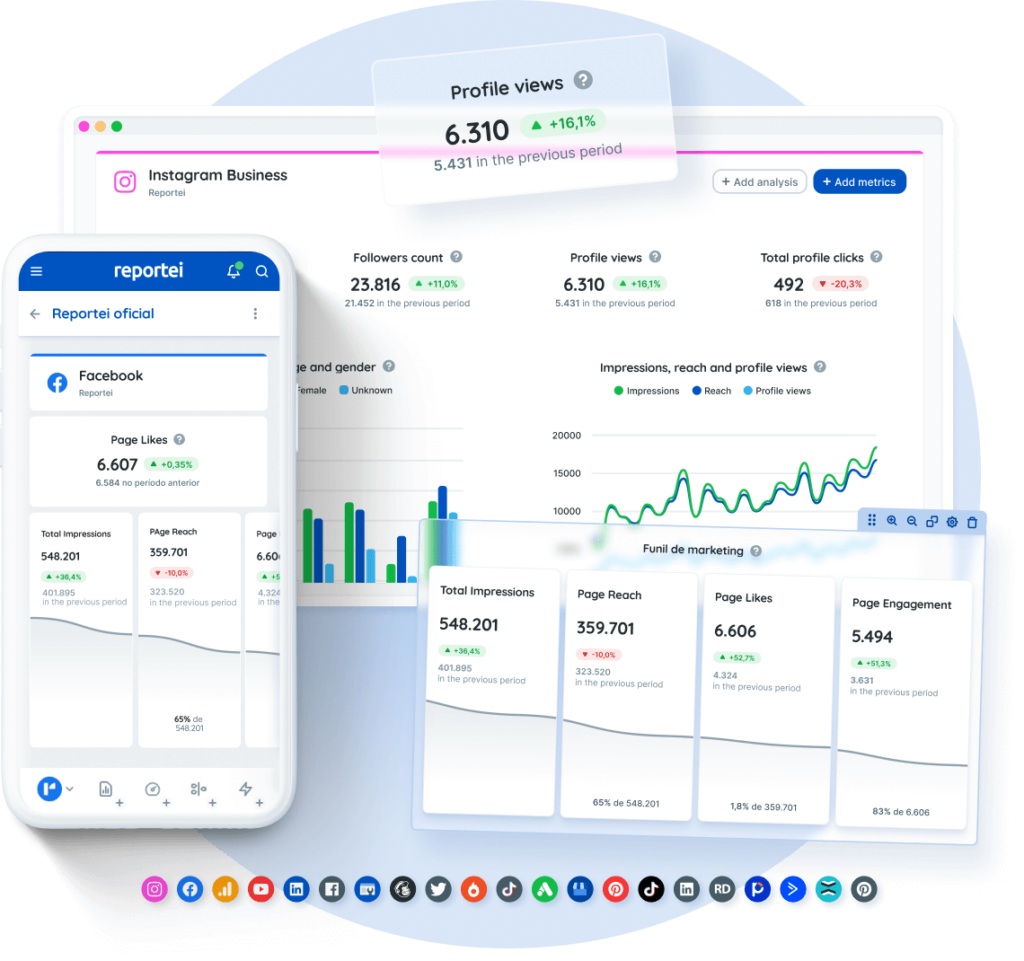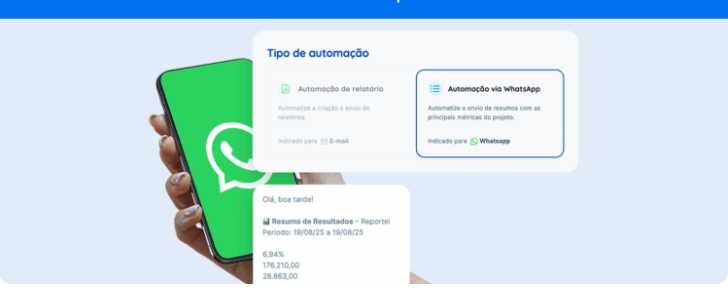Learn what paid traffic is, get tips to start working with this strategy, and how to conduct more accurate analyses in your routine
For those looking for an efficient way to increase their website’s visibility, reach new audiences, and boost conversions, learning how to do paid traffic is essential.
But if you don’t know where to start, don’t worry. In this article, we will explore the main strategies to adopt, from choosing the ideal platforms to creating and optimizing effective campaigns.
Whether you are a beginner wanting to understand the basics or a professional looking to refine your skills, this guide offers insights to maximize your return on investment (ROI) and achieve your business goals. Follow along!
What is Paid Traffic?
Paid traffic is a strategy to attract visitors to a website and increase conversions through paid advertisements on various digital platforms.
Unlike organic traffic, which is achieved through efforts in search engine optimization (SEO) and content marketing, paid traffic is acquired through advertising campaigns that involve a financial investment. Therefore, it stands out for offering:
- Speed of Results: It helps increase the number of visitors to the website almost instantly after the campaign starts.
- Precise Targeting: Advertising platforms like Google Ads and social media such as Facebook, Instagram, and LinkedIn offer advanced targeting tools. This allows advertisers to direct their ads to specific audiences based on criteria like age, location, interests, behaviors, and more.
- Budget Control: One of the advantages of paid traffic is the flexibility in budget control. Advertisers can set how much they want to spend per day or per campaign, adjusting their investments as needed.
- Ease of Measurement and Analysis: Paid traffic campaigns come with a range of metrics and analytical data that allow advertisers to measure the effectiveness of their ads in real-time. This facilitates adjustments and optimizations to maximize ROI.
- Diversity of Formats: Paid ads can take various forms, including text creatives, banners, videos, and sponsored posts on social media. This diversity allows advertisers to choose the format that best fits their goals and audience.
Given this, we can see how paid traffic is a powerful tool for any digital marketing strategy, providing the quickest results and the ability to measure campaign success in real-time.
Click on the video below to set the subtitle to your language:
How to Start Doing Paid Traffic?
Starting a paid traffic campaign can seem challenging, but with a structured approach, you can achieve your marketing goals effectively. Here is a step-by-step guide to help you get started:
1. Define Your Goals
Before starting any campaign, it’s crucial to know exactly what you want to achieve. Your objectives can include:
- Increasing website traffic
- Generating qualified leads for your business
- Boosting sales
- Promoting an event, for example
Regardless of your goal, clear objectives will help guide your decisions and measure the campaign’s success more easily in the future.
2. Know Your Target Audience
Understanding your audience is fundamental to creating effective ads. Consider factors such as age, location, interests, behaviors, and needs to test segmentations and refine the campaigns run.
Tools like Google Analytics and social media insights can provide valuable data about your audience, helping to build more precise segments.
3. Choose the Right Platform
The choice of ad platform depends on where your audience is most active. Among the most popular options are:
- Google Ads: Ideal for reaching bottom-of-the-funnel audiences through Google searches and keeping the brand top of mind with Display Network ads.
- Meta Ads: Excellent for detailed segmentation based on interests and behaviors, reaching various segments on Facebook and Instagram.
- LinkedIn Ads: Perfect for B2B campaigns, targeting professionals and companies.
- TikTok Ads: The right choice for those looking to reach a younger audience in a fun, creative, and authentic way.
- Bing Ads: A good alternative to Google Ads, offering potentially lower cost-per-click and the ability to reach a diverse audience.
Additionally, consider other growing platforms in paid traffic strategies, such as X Ads (formerly Twitter Ads) and Pinterest Ads, depending on the users you want to reach and business objectives.
4. Set the Budget
Next, establish how much you are willing to spend on your campaigns. A good tip is to start with a smaller budget to test the effectiveness of your ads and then adjust it as needed.
Also, set daily or weekly limits to control your spending and avoid unpleasant surprises throughout the campaign duration.
5. Create Attractive Ads
Effective ads should be engaging and relevant to your audience. Consider the following elements when establishing a strategy:
- Clear and concise text: Keep your text straightforward, highlighting the benefits of your product or service.
- Call to Action (CTA): Include clear CTAs for the action you want the user to take, such as “Buy Now,” “Learn More,” or “Sign Up.”
- High-quality images and videos: Use attractive visuals that capture attention and convey your message.
6. Set Up and Launch the Campaign
Each ad platform has its own setup process. Typically, this involves creating an account, defining the target audience, choosing the ad format, setting the budget, and launching the campaign.
Follow the specific guidelines of the chosen platform and pay attention to details to ensure it delivers the best results.
7. Monitor and Optimize
Once the campaign is live, monitor its performance regularly. Use the analytical tools provided by the platform or reporting tools to track key metrics and make better decisions based on the data.
Paid traffic is a continuous process of testing and optimization. Experiment with different ad formats, target audiences, and CTAs to discover what works best for your business. By learning from the results, you can refine your strategy and achieve better ROI over time.
What Metrics to Analyze in a Paid Traffic Strategy?
Monitoring and analyzing the right metrics is crucial for the success of any paid traffic campaign. Below are the key metrics you should track to evaluate the effectiveness of your campaigns and optimize your results, regardless of the platform you invest in:
- Impressions: The number of times your ad was displayed to users. This data indicates the reach of your campaign and its potential to attract clicks.
- Clicks: The number of times users clicked on your ad, revealing the initial interest of the audience in your offer.
- Click-Through Rate (CTR): The percentage of people who clicked on the ad in relation to the number of impressions. This helps you understand the relevance and effectiveness of your ad, as a high CTR suggests that the ad is attractive to the target audience.
- Cost per Click (CPC): The average amount paid for each click on the ad. This helps you understand the cost of attracting visitors to your site and manage your budget.
- Conversions: The number of desired actions completed by users, such as purchases, sign-ups, or downloads. This measures the success of the campaign in terms of achieving specific business objectives.
- Conversion Rate: The percentage of visitors who completed the desired action. This evaluates the effectiveness of the campaign in converting visitors into customers or leads.
- Cost per Acquisition (CPA): The average cost to acquire a customer or lead, helping to assess the economic efficiency of the campaign.
- Return on Investment (ROI): A metric that evaluates the profitability of the campaign. It indicates the value generated by the campaign relative to its cost, justifying the investment.
Continuously analyzing these metrics allows you to identify strengths and weaknesses in your paid traffic. Strategy based on the collected data, you can:
- Adjust Ad Texts, Images, and Calls to Action (CTAs): Optimize your ads to improve their performance by tweaking the messaging, visuals, and CTAs to make them more compelling and relevant to your audience.
- Refine Targeting: Fine-tune your audience segments to reach a more relevant audience, ensuring that your ads are seen by people who are most likely to be interested in your products or services.
- Allocate Investments to High-Performing Campaigns and Ads: Direct your budget towards the campaigns and ads that show the best performance, maximizing the return on your investment.
- Improve Landing Pages: Enhance the design, content, and user experience of your landing pages to increase conversion rates, ensuring that visitors complete the desired actions.
By monitoring and adjusting your campaigns according to these metrics, you can maximize the effectiveness of paid traffic and achieve better results for your business.
Generate more efficient paid traffic reports with Reportei
If you want to monitor paid traffic metrics more efficiently and gain the best insights for your strategies, Reportei can assist in this process. In addition to automatically capturing metrics from the main channels, our platform allows you to:
- Create Custom Dashboards: Facilitate routine analyses and real-time optimizations by setting up personalized dashboards that display the most relevant metrics for your campaigns.
- Generate Reports with AI-Driven Analysis: Take advantage of insights provided by AI-powered analysis and the paid traffic management assistant, obtaining instant recommendations for improvement.
- Closely monitor goals and spending on ad platforms using the indicator control tool
- Utilize exclusive templates to analyze your paid media strategies – some of which are recommended by industry experts

In other words, we offer a comprehensive tool to make analyses more practical and efficient, regardless of the paid traffic channel you invest in. Take advantage of our 3-day free trial to experience all the benefits firsthand!



